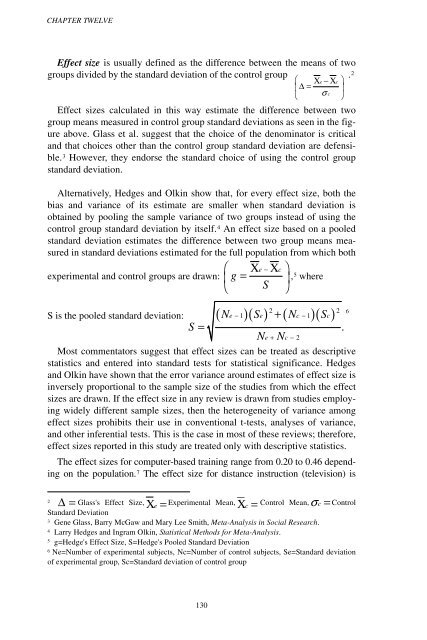Analytic Culture in the U.S. Intelligence Community (PDF) - CIA
Analytic Culture in the U.S. Intelligence Community (PDF) - CIA
Analytic Culture in the U.S. Intelligence Community (PDF) - CIA
Create successful ePaper yourself
Turn your PDF publications into a flip-book with our unique Google optimized e-Paper software.
CHAPTER TWELVE<br />
Effect size is usually def<strong>in</strong>ed as <strong>the</strong> difference between <strong>the</strong> means of two<br />
groups divided by <strong>the</strong> standard deviation of <strong>the</strong> control group ⎛ Χ−Χc ⎞ .2<br />
⎜ ∆= e ⎟<br />
⎝ σ c<br />
⎠<br />
Effect sizes calculated <strong>in</strong> this way estimate <strong>the</strong> difference between two<br />
group means measured <strong>in</strong> control group standard deviations as seen <strong>in</strong> <strong>the</strong> figure<br />
above. Glass et al. suggest that <strong>the</strong> choice of <strong>the</strong> denom<strong>in</strong>ator is critical<br />
and that choices o<strong>the</strong>r than <strong>the</strong> control group standard deviation are defensible.<br />
3 However, <strong>the</strong>y endorse <strong>the</strong> standard choice of us<strong>in</strong>g <strong>the</strong> control group<br />
standard deviation.<br />
Alternatively, Hedges and Olk<strong>in</strong> show that, for every effect size, both <strong>the</strong><br />
bias and variance of its estimate are smaller when standard deviation is<br />
obta<strong>in</strong>ed by pool<strong>in</strong>g <strong>the</strong> sample variance of two groups <strong>in</strong>stead of us<strong>in</strong>g <strong>the</strong><br />
control group standard deviation by itself. 4 An effect size based on a pooled<br />
standard deviation estimates <strong>the</strong> difference between two group means measured<br />
<strong>in</strong> standard deviations estimated for <strong>the</strong> full population from which both<br />
⎛ Χe − Χc ⎞<br />
experimental and control groups are drawn: ⎜ g = ⎟ , 5 where<br />
⎝ S ⎠<br />
2 2 6<br />
S is <strong>the</strong> pooled standard deviation: (Ne − 1)(Se ) + (Nc − 1)(Sc )<br />
S = .<br />
e + N Nc − 2<br />
Most commentators suggest that effect sizes can be treated as descriptive<br />
statistics and entered <strong>in</strong>to standard tests for statistical significance. Hedges<br />
and Olk<strong>in</strong> have shown that <strong>the</strong> error variance around estimates of effect size is<br />
<strong>in</strong>versely proportional to <strong>the</strong> sample size of <strong>the</strong> studies from which <strong>the</strong> effect<br />
sizes are drawn. If <strong>the</strong> effect size <strong>in</strong> any review is drawn from studies employ<strong>in</strong>g<br />
widely different sample sizes, <strong>the</strong>n <strong>the</strong> heterogeneity of variance among<br />
effect sizes prohibits <strong>the</strong>ir use <strong>in</strong> conventional t-tests, analyses of variance,<br />
and o<strong>the</strong>r <strong>in</strong>ferential tests. This is <strong>the</strong> case <strong>in</strong> most of <strong>the</strong>se reviews; <strong>the</strong>refore,<br />
effect sizes reported <strong>in</strong> this study are treated only with descriptive statistics.<br />
The effect sizes for computer-based tra<strong>in</strong><strong>in</strong>g range from 0.20 to 0.46 depend<strong>in</strong>g<br />
on <strong>the</strong> population. 7 The effect size for distance <strong>in</strong>struction (television) is<br />
Control Mean, σc = Control<br />
Standard Deviation<br />
3<br />
Gene Glass, Barry McGaw and Mary Lee Smith, Meta-Analysis <strong>in</strong> Social Research.<br />
4<br />
Larry Hedges and Ingram Olk<strong>in</strong>, Statistical Methods for Meta-Analysis.<br />
5<br />
g=Hedge's Effect Size, S=Hedge's Pooled Standard Deviation<br />
6<br />
Ne=Number of experimental subjects, Nc=Number of control subjects, Se=Standard deviation<br />
of experimental group, Sc=Standard deviation of control group<br />
2<br />
∆=Glass's Effect Size, Χe = Experimental Mean, Χc =<br />
130
















